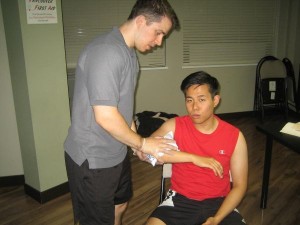Elbow bone spurs are described as unusual bony growths that can disrupt with optimum joint functionality. Lingering inflammation that is association with certain conditions such as bursitis, arthritis or tendinitis typically leads to the growth of bone spurs within the elbow. The potential symptoms of bone spurs include the following:
https://www.youtube.com/watch?v=HCoOpxXelW0
- Stiffness
- Joint pain
- Hardened lump close to the joint
- Difficulty straightening the elbow
- Weakened grip and numbness or tingling of the fourth and fifth fingers
In most cases, elbow bone spurs are managed with over-the-counter pain medications or even surgery. Once any of these symptoms are present, there is a possibility that the individual has elbow bone spurs. It is best to schedule an appointment with a doctor so that proper assessment can be carried out.
Anti-inflammatory medications

Bursitis and tendinitis of the elbow can trigger swelling in these tissues. The swelling causes friction in between the tissues and elbow bone spurs, thus triggering pain. Anti-inflammatory medications such as ibuprofen, naproxen or aspirin can minimize the inflammation and swelling in the bursae or tendons. By reducing the swelling, it minimizes the rubbing action against the bone spurs, usually resulting to pain relief.
Individuals who end up with elbow bone spurs caused by arthritis are usually given prescription anti-inflammatory medications or an injection of steroids into the joint can help reduce the inflammation, pain and swelling experienced by the individual.
Application of ice
An acute flare-up linked with elbow bone spurs might respond to the application of ice packs in the affected area. Using ice works by reducing the swelling that helps in minimizing the friction against the bone spur. Ice will not help reduce the chronic pain linked with an elbow bone spur.
Arthroscopic surgery
The doctor will oftentimes recommend arthroscopic surgery for the elbow bone spurs that cause persistent pain or loss of joint function. During this procedure, the surgeon creates several small-sized incisions around the affected elbow joint.
An arthroscope is used by the surgeon to see the elbow joint. With the help of the arthroscope, the surgeon can remove the bone spurs and other tissue debris that might cause pain and interfere with the joint mobility. Arthroscopic surgery is often beneficial for individuals with sore elbow bone spurs due to osteoarthritis.
Joint replacement
Bone spurs are considered as a main contributing factor to joint deformities that occur with osteoarthritis. Once the cartilage in the joint wears out, the bones close to the joint overgrows and develops large-sized spurs, thus deforming the joint and reducing mobility.
Among individuals who have severe elbow arthritis and joint deformity, replacement of the elbow joint is highly beneficial for pain relief as well as restoration of joint function.
Depending on the severity of the elbow bone spurs, these treatment options can help provide relief. In severe cases though, the advanced options might be the preferred choices.
